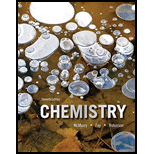
Use the values of
Is It possible to synthesize dichloroethane from gaseous
Want to see the full answer?
Check out a sample textbook solution
Chapter 17 Solutions
Chemistry
- Use the following equations to calculate the heat of the reaction for the synthesis of diborane. 2B(s) + 3/2 O2(g) → B2O3(s) ∆ Ho = -1273 kJ B2H6(g) + 3 O2(g) → B2O3(s) + 3H2O(g) ∆ Ho = -2035 kJ H2(g) + 1/2 O2(g) → H2O(l) ∆ Ho = -286 kJ H2O (l) → H2O (g) Δ Ho = 44 kJ Calculate ∆Ho for the following reaction:2B(s) + 3H2(g) → B2H6(g)arrow_forwardGiven the following combustion data for three different fuels: CH4 (g), C8H18 (l) and CH3OH (l),CH4 (g) + 2 O2 (g) → CO2 (g) + 2 H2O (l) ΔH° = −890 kJ2 C8H18 (l) + 25 O2 (g) → 16 CO2 (g) + 18 H2O (l); ΔH°= −10,914 kJ2 CH3OH (l) + 3 O2 (g) → 2 CO2 (g) + 4 H2O (l) ΔH° = −1453 kJwhich fuel provides the most energy per gram upon combustion and which provides the least? could you please explain this problemarrow_forwardUse the following equations to calculate the heat of the reaction for the synthesis of diborane. 2B(s) + 3/2 O2(g) → B2O3(s) ∆ Ho = -1273 kJ B2H6(g) + 3 O2(g) → B2O3(s) + 3H2O(g) ∆ Ho = -2035 kJ H2(g) + 1/2 O2(g) → H2O(l) ∆ Ho = -286 kJ H2O (l) → H2O (g) Δ Ho = 44 kJ Calculate ∆Ho for the following reaction:2B(s) + 3H2(g) → B2H6(g)Use kJ for your answer.arrow_forward
- Find the standard enthalpy of formation of ethylene, C2H4(g), given the following data: C2H4(g) + 3 O2(g) → 2CO2(g) + 2 H2O(l) ΔH° = -1411 kJ ;C(s) + O2(g) → CO2(g) ΔH° = -393.5 kJ ;H2(g) + 1/2 O2(g) → H2O(l) ΔH° = -285.8 kJ Question 2 options:arrow_forwardChloroform, CHCl3, is formed from methane and chlorine in the following reaction. CH4(g) + 3 Cl2(g) → 3 HCl(g) + CHCl3(g) Calculate ΔrH°, the enthalpy change for this reaction, using the enthalpies of formation of CO2(g), H2O(ℓ), CHCI3(g) (ΔfH° = -103.1 kJ/mol), and the enthalpy changes for the following reactions: CH4(g) + 2 O2(g) → 2 H2O(ℓ) + CO2(g) ΔrH° = -890.4 kJ/mol-rxn 2 HCl(g) → H2(g) + Cl2(g) ΔrH° = +184.6 kJ/mol-ransarrow_forwardConsider the following reaction: 3 C(s) + 4 H₂(g) →→ C3H8(g) Which of the following statements is correct about this reaction? Use the following reactions and thermodynamic data: Reaction: C3H8(g) + 5 O2(g) → 3 CO₂ (g) + 4H₂O C(s) + O₂(g) → CO₂(g) 2 H₂(g) + O₂(g) → 2H₂O(g) AG=-23.4 kJ AS >0 The reaction is non-spontaneous The reaction is spontaneous not enough information is given AS <0 AG rxn (kJ) -394.4 -457.1 karrow_forward
- A 0.656-g sample of acetylsalicylic acid (C9H8O4) is burned in a bomb calorimeter and the temperature increases from 24.30 °C to 26.70 °C. The calorimeter contains 1.20×103 g of water and the bomb has a heat capacity of 906 J/°C. Based on this experiment, calculate ΔE for the combustion reaction per mole of acetylsalicylic acid burned (kJ/mol).C9H8O4(s) + 9 O2(g) ---> 9CO2(g) +4H2O(I)arrow_forward2. Please calculate the standard enthalpy of reaction (AHrxn, in kJ/mol) for the preparation of nitrous acid, HNO2, using the thermodynamic data given below. Preparation of nitrous acid: HCl(g) + NaNO2(s) → HNO2(1) + NaCl(s) 2NaCl(s) + H₂O(l) → 2HCl(g) + Na₂O(s) NO(g) + NO₂(g) + Na2O(s) → 2NaNO2 (s) NO(g) + NO₂(g) → N₂O(g) + O₂(g) 2HNO2(1)→ N₂O(g) + O2(g) + H₂O(g) H₂O(1)→ H₂O(g) ΔΗ = 507.31 kJ/mol AH = -427.14 kJ/mol AH = - 42.68 kJ/mol 34.35 kJ/mol ΔΗ ΔΗ = 44.012 kJ/mol =arrow_forward19 Hydrogenation of double and triple bonds is an important industrial process. Calculate (in kJ) the standard enthalpy change ΔH° for the hydrogenation of ethyne (acetylene) to ethane using average bond enthalpies (use exam data sheet values). H–C≡C–H(g) + 2H2(g) → H3C–CH3(g)arrow_forward
- Which of the following compounds has the standard formation of free energy Δ G°f = 0? C (g) O (g) O2 (g) NO (g)arrow_forwardWhen glucose (C6H12O6) is combusted, it produces CO2 (g) and H2O (l). What is the enthalpy for the complete combustion of one mole of glucose? (The Hf for glucose is -1274.4. Use the thermodynamic tables handed out in class to calculate the answer for this question.)arrow_forward2.045 g of a new compound with formula C9H8O2 is burned in a bomb calorimeter. During the combustion, the temperature of the calorimeter increases from 21.811 °C to 29.551 °C. [During calibration, the heat capacity of the calorimeter was found to be 11.75 kJ·°C-1.] What is ΔUcomb for this compound in kJ/mol?arrow_forward
 Chemistry: Principles and PracticeChemistryISBN:9780534420123Author:Daniel L. Reger, Scott R. Goode, David W. Ball, Edward MercerPublisher:Cengage Learning
Chemistry: Principles and PracticeChemistryISBN:9780534420123Author:Daniel L. Reger, Scott R. Goode, David W. Ball, Edward MercerPublisher:Cengage Learning Chemistry for Engineering StudentsChemistryISBN:9781337398909Author:Lawrence S. Brown, Tom HolmePublisher:Cengage Learning
Chemistry for Engineering StudentsChemistryISBN:9781337398909Author:Lawrence S. Brown, Tom HolmePublisher:Cengage Learning

